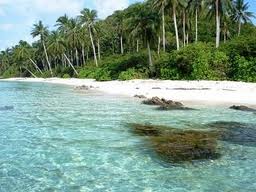Karimunjawa marine national park is located west from Jepara. This area consists of 27 islands and only four inhabited islands are Karimunjawa Island (4.302 ha), Kemujan Island (1.501 ha), Parang Island (690 ha) and Nyamuk Island (125 ha). Karimunjawa marine national park is a marine conservation area with the potential flora, fauna and marine ecosystems are typical. There are found 33 species of coral reefs and other marine biota of the coral reef develop complex ecosystem but fragile. Unfortunately, until now there is damage to coral reefs that are serious enough in the territorial waters of several islands in the Marine National Park.
The occurrence of damage in one of the internal components of the ecosystem of coral reefs will largely affect the survival of the other components as a whole. The existence of coral reefs contribute to the survival of many species at times reach more than 3,000 species, but the diversity and abundance of biota which cannot be justified if the operating pressure exceeds the carrying capacity of coral reefs.
To maintain the existence of coral reefs, the local population plays very important role in the conservation of coral reefs. Most local citizens of karimunjawa traditional lifestyles as fishermen.
Potential of Karimunjawa Marine National Parks
Fishery Potential
Usually the waters of coral reefs have high productivity but it is a closed ecosystem. The fish densities are high and can't be maintained continuously for the intense pressure overload and should be avoided. For fish species that has a fairly high economic value, have been tried to cultivate it, such as : Baronang (Siganus spp), Kakap (Lates calcarifer), snapper (Lutjanus altifrontalis) and grouper (Epinephelus spp).
Marine Algae Potential
Marine algae have an important role in marine life and some of them beneficial to mankind. in marine ecosystems, marine algae (seaweed) has a major role in the food chain cycle, because it can produce organic substances from inorganic elements. Seaweed is also important for marine organisms as food and shelter or nesting places. Seaweed for human use as food, medicines, cosmetics, animal feed, organic fertilizer, etc.
The potential of seaweed in Indonesia when cultivated intensively still inadequate for the world needs, because the world demand for seaweed is 10 times that of existing inventory worldwide.
Sea Cucumber Potential
Sea cucumbers in China, Hong Kong and many other countries well known as food. Cultivation of sea urchins have good prospects as an export commodity and requires considerable capital. The methods of sea cucumbers cultivation is simple and does not require big capital. Sea cucumbers food's such as algae, plankton detrius, small mollusks that available in natural waters.
Crab Potential
Crab cultivation in Indonesia has not received attention comparison with the cultivation of other marine fauna. The consumption needs gain from crab catch. Hall of brackish waters of Central Java have been successfully developed techniques crab cultivation. This is a good implement breakthrough for crab potential in Karimunjawa marine National Parks. (Source : Proceeding Ekplorasi Karimunjawa, UGM Yogyakarta / CC by sa)
skip to main |
skip to sidebar

Natural features and ecology, including plants and animals, scientific interest, recreational and educational value of great beauty.
Stories
Activities
Buffer Zone
Creativity
Ecology
Environment
Familiar Food for Medicine
Flora
Fruit and Vegetable Juices for Healing
Garden
Health Problems
Horizontal Lines
Indonesia National Park
Kerak Telor
National Park Photo's
People
Pollution
Seven Wonders Of Indonesia
The City
The Tribe
Tourism
Transportation
Travel Note
Popular Posts
-
Traditional Conservation of The Yawa Tribe Yapen Tengah Nature Reserve Irian Jaya In Irian Jaya, almost every tribe has its own tra...
-
Orchids have long been used as traditional herbal medicine with the kingdom in the past. Like China, Japan, India, Egypt and Turkey, inclu...
-
Beach is a favorite place for most people for vacation, but many of them don't realize that the beach is easily contaminated. So be ca...
Blog Archive
Followers
About Me

- Renren Rendra Megantara
- Bandung, West Java, Indonesia
- Learning is the key to make your brain healthy, fresh and always useful for any conditions of life
Powered by Blogger.
Copyright (c) 2010 Related Of Environment (ROE). Design by FreeCssTemplates
Themes By Buy My Themes And Top VPS Hosting.





